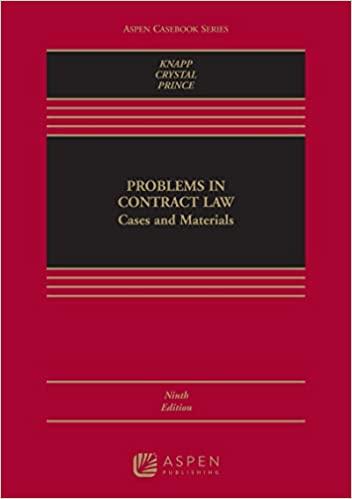Question
Introduction: Defective or dangerous products are the cause of thousands of injuries every year in the U.S. Products Liability is a field of tort law
Introduction:
Defective or dangerous products are the cause of thousands of injuries every year in the U.S. Products Liability is a field of tort law which concerns the responsibility of a product manufacturer or vendor to ensure that products are safe and do not cause injury in the hands of consumers. Generally, products liability law requires a product to meet a consumer's ordinary expectations. When a product has an unexpected defect or danger, the product cannot be said to meet the ordinary expectations of the consumer.
Concept Review:
Torts are most commonly classified as intentional, negligent, or strict liability torts. Each category of torts differs in terms of the elements needed to prove the tort, the available damages, the available defenses, and the degree of willfulness of the party allegedly committing the tort.
Strict tort liability is liability without fault. As described in your text, "Today, the theory of strict liability is used most commonly when the plaintiff is claiming to have been injured by a product that was unreasonably dangerous." In a strict tort product liability case, the plaintiff does not have to establish that the defendant intended to cause the plaintiff harm or that the defendant was negligent. Product liability is neither an intentional tort or a negligence claim. Instead, the plaintiff need only establish that: (1) the product the plaintiff purchased from the defendant was defective; and (2) the plaintiff sustained harm (and damages) as a result.
Case:
Please read the CBS News case, "IKEA to pay $46 million to settle lawsuit over child killed by tipped dresser(Links to an external site.)."
REQUIREMENTS:
- Please explain whether negligence or products liability, a combination of the two theories, or none of the theories of recovery would typically be used by the plaintiff in a case like the above IKEA case? As part of your answer, please define negligence, identify the four elements of negligence, and compare the facts to the four elements of negligence. Further, please define products liability and compare the facts to a product liability theory of recovery. Please remember to define all critical terms and to reference information from the article in your analysis.
- In the above case, the parties did not go to trial. Rather, the parties settled, meaning that they followed some form of Alternative Dispute Resolution, such as mediation or arbitration. Why would IKEA prefer to settle tipped-dresser cases instead of going to trial? Which type of Alternative Dispute Resolution would the parties likely employ: mediation or arbitration?
- If you owned a florist business and you were served process because a customer filed suit against you after slipping on some water in your store, what would you do? How would you respond to the summons? Would you prefer trial or Alternative Dispute Resolution?
Step by Step Solution
There are 3 Steps involved in it
Step: 1

Get Instant Access to Expert-Tailored Solutions
See step-by-step solutions with expert insights and AI powered tools for academic success
Step: 2

Step: 3

Ace Your Homework with AI
Get the answers you need in no time with our AI-driven, step-by-step assistance
Get Started


